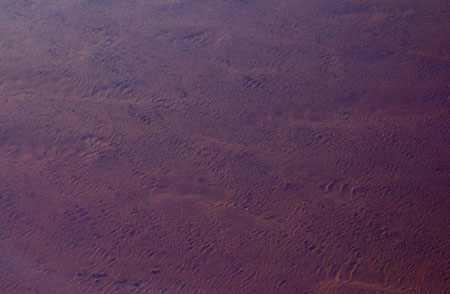The Sahara from 10,000 Meters

The dimensions of the Sahara Desert required my mind to stretch itself in able to fit the desert in. It is enormous, and maybe even bigger than that. We left Paris in the early hours of the afternoon and crossed the winter Mediterranean, which lay blanketed with clouds, and penetrated the African continent in Algeria, where the clouds gave way. From my airplane's window I looked down and saw villages, roads, and little bodies of water with flat edges where they pressed up against embankments. But minutes later the villages began to diminish, and minutes after that as I looked down the landscape was empty of the signs of human habitation.
Africa takes some mental redimensioning to understand, and after several weeks on both sides of the continent I still find myself surprised at how much greater distances are than they appeared on the map. Senegal to Cotonou, for example, looks like a simple hop from one side of West Africa to the other, but it's geographically equivalent to a flight from Miami to Boston.
The dimensions of the Sahara Desert required my mind to stretch itself in able to fit the desert in. It is enormous, and maybe even bigger than that. We left Paris in the early hours of the afternoon and crossed the winter Mediterranean, which lay blanketed with clouds, and penetrated the African continent in Libya, where the clouds gave way. From my airplane's window I looked down and saw villages, roads, and little bodies of water with flat edges where they pressed up against embankments. But minutes later the villages began to diminish, and minutes after that as I looked down the landscape was empty of the signs of human habitation.
But it was not empty. We were entering the Sahara at 10,000 meters of altitude, but even from that altitude the Sahara was full of features, and even the desert's color underwent a subtle evolution as I watched the great emptiness pass beneath me. What seemed hard and baked flat at one point softened before long and grew wavy, the waves of sand growing more regular until the dunes resembled a golden sea of storm swell waves marching off to the west. Then the waves melted back into a rough surface, which darkened. At another point we passed over an enormous meseta of sorts, whose rough skirt gathered in deep, dark folds against the desert light. The glint of bright, featureless desert extended for as far as I could see to the west, and the desert swelled beneath my eyes for hours as we pressed southward. The light faded before the desert did, and I never saw the transition from desert to Sahel in the darkness of the African night.
What I saw instead were occasional fires that glowed red from Africa's interior as Algeria drifted into Mali, and then Western Niger. Somewhere in the darkness we crossed the Niger River, and then the Atlantic was upon us and the lights of Cotonou were below. But the immense feeling the Sahara gave me did not leave me in spite of being insulated from its menace by the pressurized cabin and 10,000 meters of airspace. It's unnerving to note such emptiness, and so much of an environment that is hostile to humankind. We've long since penetrated the Sahara over centuries of exploration and there are even some that call its periphery their home. But the vast emptiness of the Sahara, even from 10,000 meters, makes you small inside, and remains a none-too-subtle reminder just how much we are dependent of the benevolence and productivity of our natural environment around us. The desert grows by several kilometers in each direction each year, of course, claiming land mistreated by humans. And that's a menace from which not even 10,000 meters of airspace can insulate us.
Trackbacks
The author does not allow comments to this entry

Comments
Display comments as Linear | Threaded